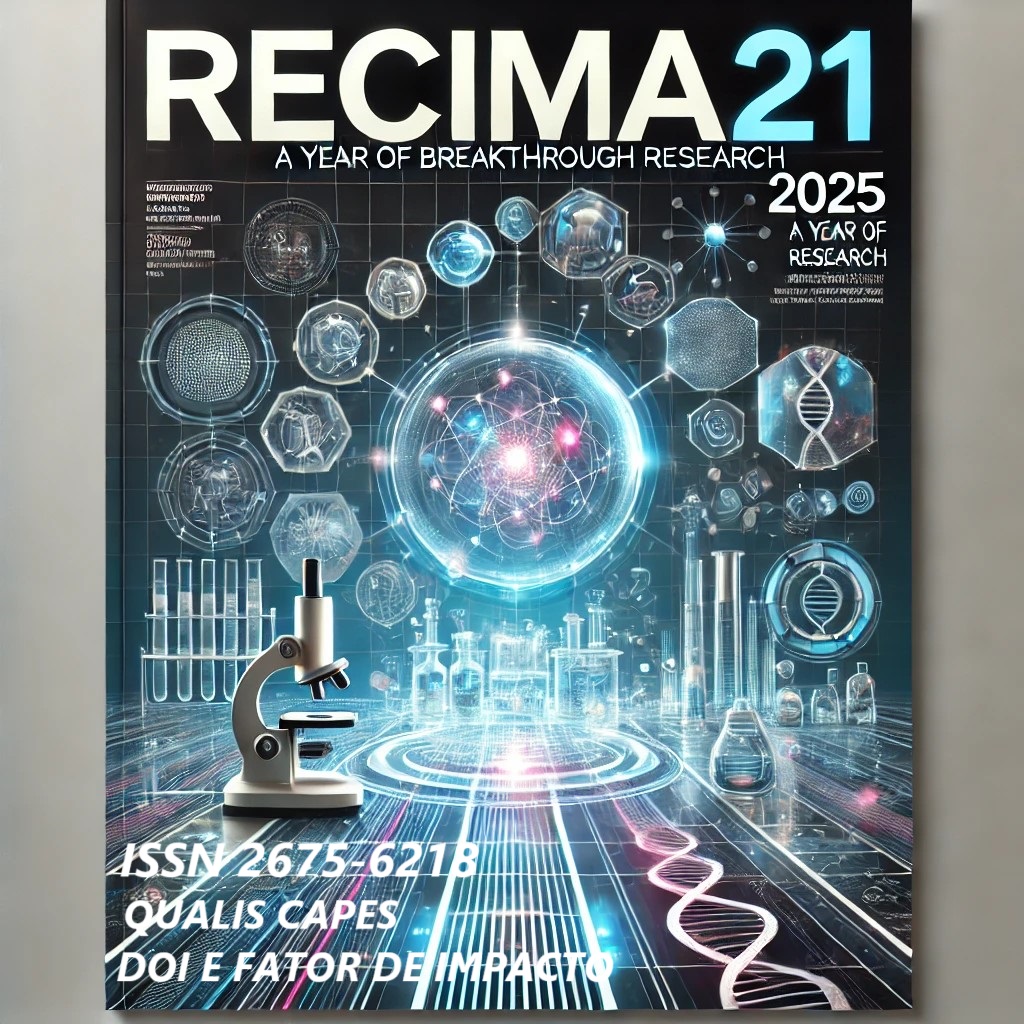O IMPACTO DAS DIMENSÕES AFETIVAS DA CONFIANÇA E DO RISCO NA CONVERSÃO DE LEADS NO AMBIENTE WEB: VALIDANDO MODELOS DE MENSURAÇÃO EMOCIONAL POR RESPOSTA IMPLÍCITA NO AMBIENTE ONLINE
DOI:
https://doi.org/10.47820/recima21.v6i4.6346Palavras-chave:
Neuro Design, Confiança Emocional-Risco Afetivo, Funil de Vendas, Landing Page, Web DesingnResumo
O objetivo deste estudo é investigar como as questões emocionais relacionadas à confiança e ao risco, alocadas nos elementos de neuro design, podem impactar a conversão de visitantes em leads em uma landing page. A ideia central é compreender como a resposta emocional, relacionada às tomadas de decisão dos indivíduos no ambiente web, impacta positivamente o desempenho nas fases iniciais do funil de vendas. A metodologia utilizada neste artigo foi desenvolvida em três fases: levantamento bibliográfico e pesquisa exploratória de campo. Na primeira fase da pesquisa, buscou-se identificar as diferenças existentes na taxa de conversão por meio de um teste A/B. Na segunda etapa, a investigação, desenvolvida com base nos conceitos de mensuração de resposta implícita (IAT), adaptou os constructos analisados, levantando dados para descrever a amostra principal e, posteriormente, compará-la ao grupo alternativo da hipótese do estudo. Os resultados obtidos indicam um vínculo entre a resposta emocional à confiança e ao risco e as conversões, especialmente em função das diferenças no perfil afetivo dos usuários. Como contribuição, o estudo oferece bases de análise para a resposta emocional aplicável ao ambiente web, com amplas possibilidades de aplicação.
Downloads
Referências
ADOPHS, R.; DAMASIO, A. R. The interaction of affect and cognition: A neurobiological perspective. In: FORGAS, J. P. The handbook of affect and social cognition. Mahwah: Erlbaum, 2001. p. 27-49. E-book. Disponível em: https://doi.org/10.4324/9781410606181.ch2. Acesso em: 31 jan. 2025.
AHLBRECHT, M.; WEBER, M. The resolution of uncertainty: an experimental study. Journal of Institutional and Theoretical Economics, Berlim, v. 152, n. 4, p. 593-677, Dec. 1996. Disponível em: http://www.jstor.org/stable/40751933. Acesso em: 26 jan. 2025.
AJZEN, I.; FISHBEIN, M. Understanding attitude and predicting social behavior. Englewood Cliffs, N. J.: Prentice-Hall, 1980.
ASH, T.; PAGE, R.; GINTY, M. Landing page optimization: the definitive guide to testing and tuning for conversions. 2 ed. Indianapolis: Willey & Sons, 2012.
AUBERT, M.; BRUM, A.; RAMLI, M.; SUTIKNA, T.; SAPTOMO, E. W.; HAKIM, B.; MORWOOD, M. J.; VAN DEN BERGH, G. D.; KINSLEY, L.; DOSSETO, A. Pleistocene cave art from Sulawesi, Indonesia. Nature, n. 514, p. 223–227, 08 Oct. 2014. Disponível em: https://doi.org/10.1038/nature13422. Acesso em: 23 jan. 2025. DOI: https://doi.org/10.1038/nature13422
BARGH, J. A. Automatic and conscious processing of social information. In: WYER, R. S.; SRULL, T. K. Handbook of social cognition. Hillsdale: Lawrence Erlbaum Associates Publishers, 1984. v. 3, p. 1-43. Disponível em: https://psycnet.apa.org/record/2011-28557-001. Acesso em: 23 jan. 2025.
BAUMEISTER, R. F.; LEARY, M. R. The need to belong: desire for interpersonal attachments as a fundamental human motivation. Psychological Bulletin, v. 117, n.3, p. 497- 529, 1995. Disponível em: https://doi.org/10.1037/0033-2909.117.3.497. Acesso em: 23 jan. 2025. DOI: https://doi.org/10.1037//0033-2909.117.3.497
BHATTACHEIJEE, A. Individual trust in online firms: Scale development and initial test. Journal of Management Information Systems, v. 19, n. 1, p. 211-241, 2002. Disponível em: https://doi.org/10.1080/07421222.2002.11045715. Acesso em: 31 jan. 2025. DOI: https://doi.org/10.1080/07421222.2002.11045715
BREZNITZ, S. A study of worrying. British Journal of Social and Clinical Psychology, v. 10, p. 271-279, 1971. Disponível em: https://doi.org/10.1111/j.2044-8260.1971.tb00747.x. Acesso em: 26 jan. 2025. DOI: https://doi.org/10.1111/j.2044-8260.1971.tb00747.x
BRIDGER, D. Neuro Design: Neuromarketing insights to boost engagement and profitability. London: Kogan Page, 2017.
CEROSALETTI, C.; LOUI, A. Measuring the perceived aesthetic quality of photographic images. International Workshop on Quality of Multimedia Experience, San Diego, CA, USA, p. 47–52, 2009. Disponível em: 10.1109/QOMEX.2009.5246977. Acesso em: 26 jan. 2025. DOI: https://doi.org/10.1109/QOMEX.2009.5246977
CHARTTERJEE, A. The aesthetic brain: how we evolved to desire beauty and enjoy art. New York: Oxford University Press, 2013. DOI: https://doi.org/10.1093/acprof:oso/9780199811809.001.0001
CLARK, L. A.; WATSON, D. Constructing validity: Basis issues in objective scale development. Psychological Assessment, v. 7, n. 3, p. 309-319, 1995. Disponível em: https://www3.nd.edu/~ghaeffel/Clark&Watson(1995).pdf. Acesso em: 25 jan. 2025. DOI: https://doi.org/10.1037//1040-3590.7.3.309
COMPEAU, D.; HIGGINS, C. A.; HUFF, S. Social cognitive theory and individual reactions to computing technology: A longitudinal study. MIS Quarterly, v. 23, n.2, p. 145- 158, 1999. Disponível em: https://doi.org/10.2307/249749. Acesso em: 26 jan. 2025.. DOI: https://doi.org/10.2307/249749
DAMASIO, A. R. Descartes’ error: emotion, reason, and the human brain. New York: Putnam, 1994.
DAVIDSON, R. J. Well-being and affective style: Neural substrates and biobehavioural correlates. Philosophical Transactions of the Royal Society B (Biological Sciences), v. 359, n. 1449, p. 1395–1411, 29 Sept. 2004. Disponível em: https://doi.org/10.1098/rstb.2004.1510. Acesso em: 26 jan. 2025. DOI: https://doi.org/10.1098/rstb.2004.1510
DOLAN, R.; SHAROT, T. Neuroscience of preference and choice: cognitive and neural mechanisms. London: Academic Press, 2012. DOI: https://doi.org/10.1016/B978-0-12-381431-9.00013-9
DONEY, P. M.; CANNON, J. P. An examination of the nature of trust in buyerseller relationship. Journal of Marketing, v. 61, n. 2, p. 35-51, Apr. 1997. Disponível em: https://doi.org/10.2307/1251829. Acesso em: 24 jan. 2025. DOI: https://doi.org/10.1177/002224299706100203
DUTTON, D. The art instinct: beauty, pleasure, and human evolution. New York: Bloomsbury Press, 2009.
EKMAN, P. Emotions revealed: Recognizing Faces and Feelings to Improve Communication and Emotional Life. New York: Times Books. 2003.
EVANS, V.; GREEN, M. Cognitive Linguistics: an introduction. 2. ed. Edinburgh: Edinburgh University Press, 2006.
FARB, N. Can neuroimaging inform economic theories of decision making? Neuroscience and Neuroeconomics, v. 2, p. 1-10, 22 jan. 2013. Disponível em: https://bit.ly/42v2opm. Acesso em: 18 mar. 2020. DOI: https://doi.org/10.2147/NAN.S39339
FOLKMAN, S.; LAZARUS, R. S.; GRUEN, R. J.; DELONGIS, A. Appraisal, coping, health status, and psychological symptoms. Journal of Personality and Social Psychology, v. 50, n. 3, p. 571–579, 1986. Disponível em: https://doi.org/10.1037//0022-3514.50.3.571. Acesso em: 26 jan. 2025. DOI: https://doi.org/10.1037//0022-3514.50.3.571
FORGAS, J. P.; GEORGE, J. M. affective influences on judgments and behavior in organizations: an information processing perspective. Organizational Behavior & Human Decision Processes, v. 86, n. 1, p. 3-34, Sept. 2001. Disponível em: https://doi.org/10.1006/obhd.2001.2971. Acesso em: 25 jan. 2025. DOI: https://doi.org/10.1006/obhd.2001.2971
GOFMAN, A.; MOSKOWITZ, H.; METS, T. Integrating Science into Web Design: Consumer Driven Website Optimization. The Journal of Consumer Marketing, v. 26, n. 4, p. 286-298, 2009. Disponível em: https://doi.org/10.1108/07363760910965882. Acesso em: 26 jan. 2025. DOI: https://doi.org/10.1108/07363760910965882
GOWARD, C. You Should test that! conversion optimization for more leads, sales and profit or the art and science of optimized marketing. Indianapolis: Willey & Sons, 2012.
GREENWALD, A. G.; BANAJI, M. R.; NOSEK, B. A. Understanding and using the Implicit Association Test: I. an improved scoring algorithm. Journal of Personality and Social Psychology, v. 85, n. 2, p. 197–216, 2003. Disponível em: https://doi.org/10.1037/0022-3514.85.2.197. Acesso em: 27 jan. 2025. DOI: https://doi.org/10.1037/0022-3514.85.2.197
HALLIGAN, B.; SHA, D. Inbound marketing: get found using Google, social midea and blogs. New Jersey: Wiley & Sons, 2010. DOI: https://doi.org/10.1002/9781118257838
JACOBUCCI, G.D. Primary appraisal as a function of attachment pattern, personality, and situational circumstances. 1998. Dissertation (Doctor of Philosophy) - Simon Fraser University, Department of Psychology – PhD, Ottawa, 1998. Disponível em: https://central.bac-lac.gc.ca/.item?id=NQ37717&op=pdf&app=Library&oclc_number=46907889. Acesso em: 26 jan. 2025.
JELODAR, H. A. Deep Learning in Attention Networks. 2017. Dissertation (Doctor of Philosophy) - State University of New York at Stony, Cognitive Science – PhD, Stony Brook University, New York, 2017. Disponível em: https://bit.ly/3PPNClE. Acesso em: 18 ago. 2019.
JOHNSON, M. The body in the mind: the bodily basis of meaning, imagination, and reason. Chicago: University of Chicago Press, 2013.
JOHNSON-GEORGE, C.; SWAP, W. C. Measurement of specific interpersonal trust: construction and validation of a scale to assess trust in a specific other. Journal of Personality and Social Psychology, v. 43, p. 1306-1317, 1982. Disponível em: https://doi.org/10.1037/0022-3514.43.6.1306. Acesso em: 24 jan. 2025. DOI: https://doi.org/10.1037//0022-3514.43.6.1306
KAHNEMAN, D. Rápido e Devagar: Duas Formas de Pensar. Rio de Janeiro: Objetiva, 2012.
KAPLAN, S.; KAPLAN, R. Cognition and environment: functioning in an uncertain world. belmont, CA: Praeger Publishers, 1983.
KARANDASHEV, V.; EVANS, N. D. Test of Implicit Associations in Relationship Attitudes (TIARA): Manual for a New Method. Gewerbestrasse: Springer International, 2017. Disponível em: https://doi.org/10.1007/978-3-319-68768-1. Acesso em: 27 jan. 2025. DOI: https://doi.org/10.1007/978-3-319-68768-1
KARIM, J.; WEISZ, R.; REHMAN, S. International positive and negative affect schedule short-form (I-PANAS-SF): testing for factorial invariance across cultures. Procedia - Social and Behavioral Sciences, v. 15, p. 2016-2022, 2011. Disponível em: https://doi.org/10.1016/j.sbspro.2011.04.046. Acesso em: 27 jan. 2025. DOI: https://doi.org/10.1016/j.sbspro.2011.04.046
KOTLER, P.; RACKHAM, N.; KRISHNASWAMY, S. Ending the war between sales & marketing. Harvard Business Review, v. 84, n. 7-8, p. 68-78, jul./aug. 2006. Disponível em: https://hbr.org/2006/07/ending-the-war-between-sales-and-marketing. Acesso em: 26 jan. 2025.
KUNREUTHER, J.; GINSBURG, R.; MILLER, L.; SAGI, P.; SLOVIC, P.; BORKAN, B.; KATZ, N. Disaster insurance protection: Public Policy Lessons. New York: Wiley, 1978. E-book. Disponível em: https://nehrpsearch.nist.gov/static/files/NSF/PB289950.pdf. Acesso em: 25 jan. 2025.
KURZWEIL, R. Como criar uma mente: os segredos do pensamento humano. São Paulo: Aleph, 2015.
LAKOFF, G. The Invariance Hypothesis: is Abstract Reason Based on ImageSchemas? Cognitive Linguistics, v. 1, n. 1, p. 39-74, 1990. Disponível em: https://doi.org/10.1515/cogl.1990.1.1.39. Acesso em: 26 jan. 2025. DOI: https://doi.org/10.1515/cogl.1990.1.1.39
LAKOFF, G.; JOHNSON, M. Metaphors we live by. Chicago: The University of Chicago Press, 2003. DOI: https://doi.org/10.7208/chicago/9780226470993.001.0001
LAVIE, T.; TRACTINSKY, N. Assessing dimensions of perceived visual aesthetics of web sites. International Journal of Human-Computer Studies, v. 60, n. 3, p. 269-298, Mar. 2004. Disponível em: https://doi.org/10.1016/j.ijhcs.2003.09.002. Acesso em: 26 jan. 2025. DOI: https://doi.org/10.1016/j.ijhcs.2003.09.002
LAZARUS, R. S. Progress on a cognitive-motivational-relational theory of Emotion. American Psychologist, v. 46, n. 8, p. 819–834, 1991. Disponível em: https://doi.org/10.1037/0003-066X.46.8.819. Acesso em: 26 jan. 2025. DOI: https://doi.org/10.1037//0003-066X.46.8.819
LEWIS, J. D.; WEIGERT, A. Trust as a social reality. Social Forces, v. 63, n. 4, p. 967-985, jun. 1985. Disponível em: https://doi.org/10.2307/2578601. Acesso em: 27 jan. 2025. DOI: https://doi.org/10.2307/2578601
LOEWENSTEIN, G. F.; WEBER, E. U.; HSEE, C. K.; WELCH, N. Risk as feelings. Psychological Bulletin, v. 127, n. 2, p. 267-286, 2001. Disponível em: http://dx.doi.org/10.1037/0033-2909.127.2.267. Acesso em: 25 jan. 2025. DOI: https://doi.org/10.1037//0033-2909.127.2.267
MANDLER, J.; CÁNOVAS, C. On defining image schemas. Language and Cognition, v. 6, n. 4, p. 510-532, 2014. Disponível em: https://www.cambridge.org/core/journals/language-and-cognition/article/abs/on-defining-image-schemas/DB4507D1AABC18DA966FB807B3D21A8A. Acesso em: 26 jan. 2025. DOI: https://doi.org/10.1017/langcog.2014.14
MARCUS, A. HCI and user-experience design: fast-forward to the past, present, and future. New York: Springer, 2015. DOI: https://doi.org/10.1007/978-1-4471-6744-0
MARSELLA, S.; GRATCH, J. Modeling coping behaviors in virtual humans: don't worry, be happy. Second International Joint Conference on Autonomous Agents and Multi-agent Systems. Melbourne, p. 313-320, 14 jul. 2003. Disponível em: https://doi.org/10.1145/860575.860626. Acesso em: 26 jan. 2025. DOI: https://doi.org/10.1145/860575.860626
MCALLISTER, D. J. Affect and cognition-based trust as foundations for interpersonal cooperation in organizations. Academy of Management Journal, v. 38, n. 1, p. 24-59, 1995. Disponível em: https://www.jstor.org/stable/256727. Acesso em: 23 jan. 2025 DOI: https://doi.org/10.2307/256727
MCKNIGHT, D. H.; CHOUDHURY, V.; KACMAR, C. Developing and Validating Trust Measures for E-Commerce: An Integrative Typology. Information Systems Research, v. 13, n. 3, p. 334-359, 2002. Disponível em: https://doi.org/10.1287/isre.13.3.334.81. Acesso em: 25 jan. 2025. DOI: https://doi.org/10.1287/isre.13.3.334.81
MCSPADDEN, K. You now have shorter attention span than a goldfish. Time, Health – Neuroscience. New York: Time, May 2015. Disponível em: https://time.com/3858309/attention-spans-goldfish/. Acesso em: 23 jan. 2025.
MIN, X.; ZHAI, G; ZHOU, J.; ZHANG, X.-P.; YANG, X.; GUAN, X. A. Multimodal saliency model for videos with high audio-visual correspondence. IEEE Transactions on Image Processing, v. 29, p. 3805-3819, Sep. 2020. Disponível em: https://doi.org/10.1109/TIP.2020.2966082. Acesso em: 23 jan. 2025. DOI: https://doi.org/10.1109/TIP.2020.2966082
MLODINOW, L. Subliminar: como o inconsciente influencia nossas vidas. Rio de Janeiro: Zahar, 2014.
MONAT, A. Temporal uncertainty, anticipation time, and cognitive coping under threat. Journal of Human Stress, v. 2, n. 2, p. 32-43, 1976. Disponível em: https://bit.ly/3CvYKks. Acesso em: 26 jan. 2025. DOI: https://doi.org/10.1080/0097840X.1976.9936064
NASAR, J. The evaluative image of places. In: WALSH, W. B.; CRAIK, K. H.; PRICE, R. H. Person-Environment Psychology. Mahwah: Lawrence Erlbaum Associates Publishers, 2001. p.117-168.
NICHOLSON, C. Y.; COMPEAU, L. D.; SETHI, R. The role of interpersonal liking in building trust in long-term channel relationship. Journal of the Academy of Marketing Science, v. 29, n. 1, p. 3-15, 2001. Disponível em: https://doi.org/10.1177/0092070301291001. Acesso em: 24 jan. 2025. DOI: https://doi.org/10.1177/0092070301291001
NORMAN, D. A. Emotional design. Ubiquity, v. 2004, jan. 2004. Disponível em: https://doi.org/10.1145/985600.966013. Acesso em: 26 jan. 2025. DOI: https://doi.org/10.1145/966012.966013
NOSEK, B. A.; BAR-ANAN, Y.; SRIRAM, N.; AXT, J.; GREENWALD, A. G. Understanding and using the brief Implicit Association Test: Recommended scoring procedures. PLoS One, v. 9, n. 12, p. 1–31, 2014. Disponível em: https://doi.org/10.1371/journal.pone.0110938. Acesso em: 27 jan. 2025. DOI: https://doi.org/10.1371/journal.pone.0110938
PANKSEPP, J. Affective neuroscience: the foundations of human and animal emotions. New York: Oxford University Press, 1998. DOI: https://doi.org/10.1093/oso/9780195096736.001.0001
PATTERSON, L. Marketing and Sales Alignment for Improved Effectiveness. Journal of Digital Asset Management, v. 3, n. 4, p. 185–189, 2007. Disponível em: https://doi.org/10.1057/palgrave.dam.3650089. Acesso em: 26 jan. 2025. DOI: https://doi.org/10.1057/palgrave.dam.3650089
RAFAELI, A.; VILNAI-YAVETZ, I. Emotion as a connection of physical artifacts and organizations. Organization Science Journal, Informs, v. 15, n. 6, p. 671-686. 2004. Disponível em: https://doi.org/10.1287/orsc.1040.0083. Acesso em: 26 jan. 2025. DOI: https://doi.org/10.1287/orsc.1040.0083
RIES, J. F. Effect of Emotion on Marketing Landing Page Conversion. 2016. Tese (Master of Science) - University of Baltimore, Information Design and Information Architecture, PhD, Baltimore, 2016. Disponível em: http://hdl.handle.net/11603/3819. Acesso em: 26 jan. 2025.
ROSEMAN, I. P. Appraisal Determinants of Emotions: Constructing a More Accurate and Comprehensive Theory. Cognition & Emotion, v. 10, p. 241-278, 1996. Disponível em: https://doi.org/10.1080/026999396380240. Acesso em: 26 jan. 2025. DOI: https://doi.org/10.1080/026999396380240
ROSS, A.; TYLER, M. Predictable revenue: turn your business into a sales machine with the $100 million best practices of salesforce.com. West Hollywood: PebbleStorm, 2011.
SCHACHTER, S.; SINGER, J. Cognitive, Social, and Physiological Determinants of Emotional State. Psychological Review, v. 69, n. 5, p. 379-399, 1962. Disponível em: https://doi.org/10.1037/h0046234. Acesso em: 26 jan. 2025. DOI: https://doi.org/10.1037/h0046234
SCHENKMAN, B. N.; JONSSON, F. U. Aesthetics and preferences of web pages. Behaviour and Information Technology, v. 19, n. 5, p. 367-37, 2000. Disponível em: https://doi.org/10.1080/014492900750000063. Acesso em: 26 jan. 2025. DOI: https://doi.org/10.1080/014492900750000063
SCHERER, K. R. Appraisal considered as a process of multilevel sequencial checking. In: SCHERER, K. R.; SCHORR, A.; JOHNSTONE, T. Appraisal processes in emotion: theory, methods, research. Oxford: Oxford University Press, 2001. p. 92-120. E-book. Disponível em: https://www.researchgate.net/publication/202304338_Appraisal_considered_as_a_process_of_multilevel_sequential_checking. Acesso em: 26 jan. 2025. DOI: https://doi.org/10.1093/oso/9780195130072.003.0005
SCHROEDER, J. E. The Marketing power of emotion. Journal of Macromarketing, v. 24, n. 1, p. 59–61, Jun. 2004. Disponível em: https://doi.org/10.1177/0276146704263817. Acesso em: 27 jan. 2025. DOI: https://doi.org/10.1177/0276146704263817
SHA, W. Beyond Cognition: the influence of affective trust and affective risk on consumer participation in electronic commerce. 2005. Dissertation (Doctor of Philosophy) - University of Arkansas, Fayetteville, 2005. Disponível em: https://bit.ly/4jRRQHl. Acesso em: 25 jan. 2025.
SINGH, A.; CHU, C. H. H.; PRATT, M. A. Multiresolution superpixels for visual saliency detection. IEEE Symposium on Computational Intelligence for Multimedia, Signal and Vision Processing (CIMSIVP), Orlando, FL, USA, p. 1-8, 2014. Disponível em: https://bit.ly/4jE0pVI. Acesso em: 23 jan. 2025. DOI: https://doi.org/10.1109/CIMSIVP.2014.7013277
TEIGE-MOCIGEMBA, S.; KLAUER, K. C.; SHERMAN, J. W. A practical guide to implicit association tests and related tasks. In: GAWRONSKI, B.; PAYNE, B. K. Handbook of implicit social cognition: measurement, theory, and applications. New York: The Guilford Press, 2010. p. 117–139. Disponível em: https://escholarship.org/uc/item/63t6n75d. Acesso em: 27 jan. 2025.
THALER, R.; SUSTEIN, C. Nudge: improving decisions about health, wealth, and happiness. London: Yale Press, 2008.
THOMPSON, E. R. Development and validation of an internationally reliable short-form of the positive and negative affect Schedule (PANAS). Journal of Cross-Cultural Psychology, v. 38, n. 2, p. 227-242, Mar. 2007. Disponível em: https://doi.org/10.1177/0022022106297301. Acesso em: 28 jan. 2025. DOI: https://doi.org/10.1177/0022022106297301
TORKZADEH, G.; DHILLON, G. Measuring factors that influence the success of Internet commerce. Information Systems Research, v. 13, n. 2, p. 187-204, jun. 2002. Disponível em: https://doi.org/10.1287/isre.13.2.187.87. Acesso em: 25 jan. 2025. DOI: https://doi.org/10.1287/isre.13.2.187.87
TUSCHE, A.; BODE, S.; HAYNES, J. Neural responses to unattended products predict later consumer choices. The Journal of Neuroscience, v. 30, n. 23, p. 8024-8031, 09 jun. 2010. Disponível em: https://doi.org/10.1523/JNEUROSCI.0064-10.2010. Acesso em: 23 jan. 2025. DOI: https://doi.org/10.1523/JNEUROSCI.0064-10.2010
TYLER, M.; DONAVAN, J. Predictable prospecting: how to radically increase your B2B sales. New York: McGraw-Hill Education, 2016.
VAN GORP, T.; ADAMS, E. Why Design for Emotion? In: VAN GORP, T.; ADAMS, E. Design for Emotion, Elsevier, 2012. 1-18. E-book. Disponível em: https://doi.org/10.1016/b978-0-12-386531-1.00001-6. Acesso em: 26 jan. 2025. DOI: https://doi.org/10.1016/B978-0-12-386531-1.00001-6
VENKATESH, V. Determinants of perceived ease of use: integrating control, intrinsic motivation, and emotion into the technology acceptance model. Information Systems Research, v. 11, n. 4, p. 342-365, Dec. 2000. Disponível em: https://pubsonline.informs.org/doi/10.1287/isre.11.4.342.11872. Acesso em: 26 jan. 2025. DOI: https://doi.org/10.1287/isre.11.4.342.11872
VERDUYN, P.; VAN MECHELEN, I.; TUERLINCKX, F. The relation between event processing and the duration of emotional experience. Emotion, v. 11, n. 1, p. 20–28, 2011. Disponível em: https://doi.org/10.1037/a0021239. Acesso em: 26 jan. 2025. DOI: https://doi.org/10.1037/a0021239
WATSON, D.; CLARK, L. A.; TELLEGEN, A. Development and Validation of Brief Measures of Positive and Negative Affect: The PANAS Scales. Journal of Personality and Social Psychology, v. 54, n. 6, p. 1063–1070, 1988. Disponível em: https://doi.org/10.1037/0022-3514.54.6.1063. Acesso em: 27 jan. 2025. DOI: https://doi.org/10.1037//0022-3514.54.6.1063
WEINSCHENK, S. M. Neuro web design: what makes them click? Berkeley: New Riders, 2009.
WHALEN, J. Design for how people think: using brain science to build better products. Sebastopol: O’Reilly Media, 2019.
WHITE, K. D. Salivation: The significance of imagery in its voluntary control. Psychophysiology, v. 15, n. 3, p. 196-203, May 1978. Disponível em: https://doi.org/10.1111/j.1469-8986.1978.tb01363.x. Acesso em: 25 jan. 2025. DOI: https://doi.org/10.1111/j.1469-8986.1978.tb01363.x
WILSON, D.; SPERBER, D. Relevance Theory. In: HORN, L.; WARD, G. The handbook of pragmatics. Oxford: Blackwell, 2004. p. 607-632. Disponível em: https://doi.org/10.1002/9780470756959.ch27. Acesso em: 26 jan. 2025. DOI: https://doi.org/10.1002/9780470756959.ch27
WOLF, T. 6 Emotional Steps that Increased Ecommerce Revenues in 30 days. Conversion Conference Blog, 2013. Disponível em https://www.conversioner.com/blog/ecommerce-conversion-optimization. Acesso em: 26 jan. 2025.
WRIGHT, P.; MCCARTHY, J.; MARSH, T. From usability to user experience. British HCI Group Members Magazine, v. 46, n. 3, p. 4-11, 2001. Disponível em: https://www.academia.edu/6273213/From_Usability_to_User_Experience. Acesso em: 31 jan. 2025.
WULF, K. D.; ODEKERKEN-SCHRODER, G.; LACOBUCCI, D. Investments in Consumer Relationships: A Cross-Country and Cross-Industry Exploration. Journal of Marketing, v. 65, n. 4, p. 33-50, 2001. Disponível em: https://doi.org/10.1509/jmkg.65.4.33.18386. Acesso em: 15 set. 2020. DOI: https://doi.org/10.1509/jmkg.65.4.33.18386
ZURAWICKI, L. Neuromarketing: Exploring the Brain of the Consumer. London: Springer, 2010. DOI: https://doi.org/10.1007/978-3-540-77829-5
Downloads
Publicado
Licença
Direitos de Autor (c) 2025 RECIMA21 -Revista Científica Multidisciplinar - ISSN 2675-6218

Este trabalho encontra-se publicado com a Licença Internacional Creative Commons Atribuição 4.0.
Os direitos autorais dos artigos/resenhas/TCCs publicados pertecem à revista RECIMA21, e seguem o padrão Creative Commons (CC BY 4.0), permitindo a cópia ou reprodução, desde que cite a fonte e respeite os direitos dos autores e contenham menção aos mesmos nos créditos. Toda e qualquer obra publicada na revista, seu conteúdo é de responsabilidade dos autores, cabendo a RECIMA21 apenas ser o veículo de divulgação, seguindo os padrões nacionais e internacionais de publicação.













